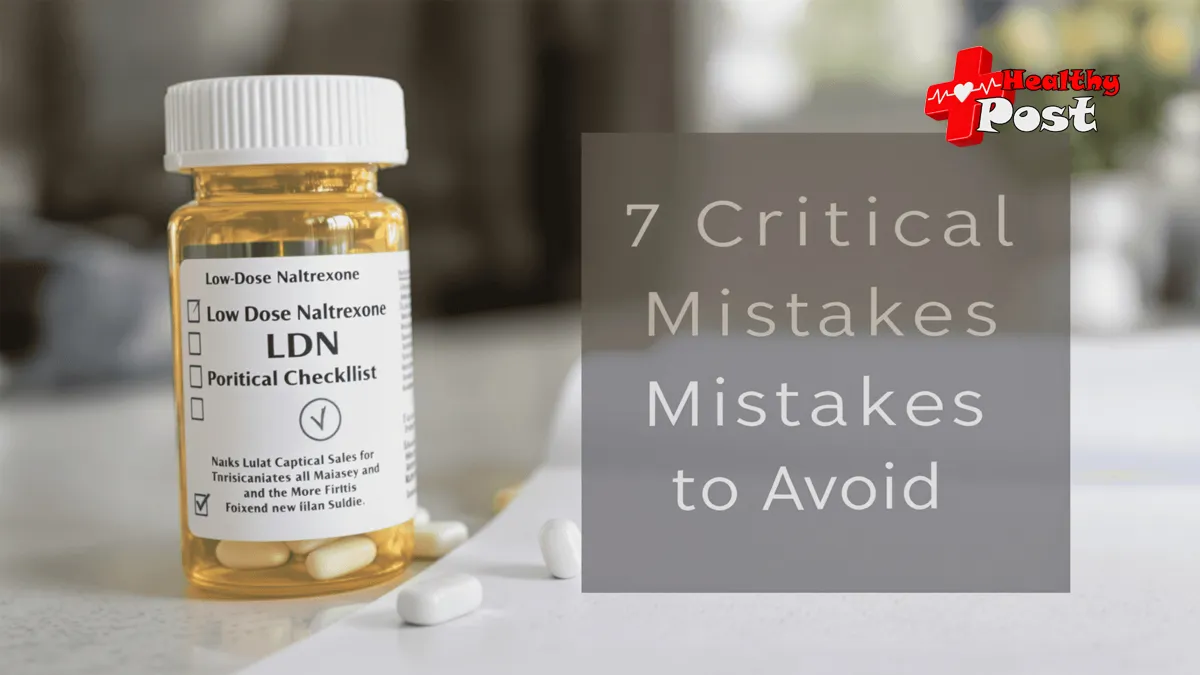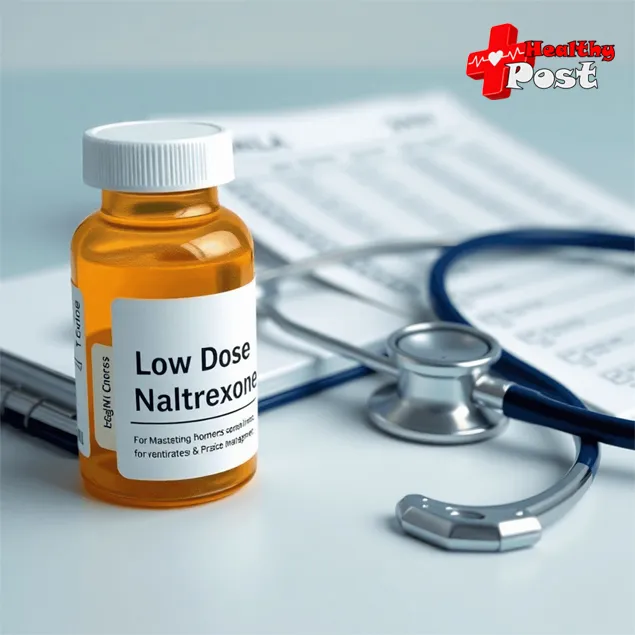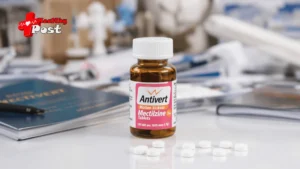
7 Critical Mistakes: What to Avoid When Taking Low Dose Naltrexone
Low Dose Naltrexone (LDN) has emerged as a groundbreaking treatment option for numerous health conditions. This prescription medication, taken in doses ranging from 0.5 to 4.5 mg daily, offers remarkable benefits for patients dealing with autoimmune disorders, chronic inflammation, and various chronic illnesses.
Key Benefits of LDN:
- Reduces inflammation throughout the body
- Improves autoimmune symptoms
- Supports immune system function
- Promotes longevity
- Enhances mood and energy levels
Your success with LDN therapy depends heavily on proper usage and understanding of the medication. Making certain mistakes can significantly impact its effectiveness or potentially lead to adverse effects. These errors can mean the difference between achieving optimal results and experiencing treatment failure.
Common Critical Mistakes to Watch For:
- Ignoring essential contraindications
- Missing important drug interactions
- Neglecting dietary considerations
- Skipping follow-up appointments
- Misinterpreting side effects
- Relying on self-diagnosis
- Using LDN without a comprehensive treatment plan
Understanding these potential pitfalls helps you navigate your LDN journey safely and effectively. Each mistake carries its own set of risks and consequences that can affect your treatment outcomes. Let’s explore these critical errors in detail to ensure you get the most out of your LDN therapy.
1. Ignoring Contraindications
Contraindications are specific conditions or factors that make Low Dose Naltrexone (LDN) potentially harmful or dangerous for certain individuals. Understanding these contraindications is crucial for your safety and treatment success.
Key Contraindications for LDN:
- Active Opioid Use: LDN blocks opioid receptors, which can trigger severe withdrawal symptoms and pose a risk of intense physical distress or even life-threatening complications.
- Liver Disease: Since LDN metabolism occurs in the liver, there is a risk of increased liver enzyme levels and potential deterioration of liver function, requiring strict medical monitoring.
- Pregnancy and Breastfeeding: Limited research exists on the effects of LDN on fetuses, with unknown risks to developing babies and potential transfer through breast milk, raising safety concerns for infant development.
Medical Conditions Requiring Caution:
- Autoimmune conditions with organ transplants
- Active cancer treatments
- Severe kidney dysfunction
- Acute hepatitis
The risks of ignoring these contraindications can be severe:
- Sudden onset of opioid withdrawal syndrome
- Deterioration of liver function
- Unexpected drug interactions
- Resistance to treatment
- Worsening of underlying health conditions
Your healthcare provider needs to conduct a thorough medical evaluation before prescribing LDN. This includes:
- Reviewing your complete medical history
- Assessing your current medications
- Conducting liver function tests
- Performing pregnancy testing when applicable
- Evaluating any existing health conditions
A proper medical screening helps identify potential contraindications and creates a safe treatment plan tailored to your specific needs. Regular monitoring ensures early detection of any adverse reactions or complications.

2. Overlooking Drug Interactions
Drug interactions with Low Dose Naltrexone can significantly impact your treatment success. A comprehensive medication review with your healthcare provider helps identify potential conflicts and ensures safe, effective therapy.
Common Medications That Interact with LDN:
- Opioid-based medications: LDN blocks opioid receptors, rendering pain medications ineffective and potentially triggering withdrawal symptoms
- Immunosuppressive drugs: These can reduce LDN’s immune-modulating benefits
- Certain antidepressants: SSRIs and SNRIs may have altered effectiveness when combined with LDN
- Anti-inflammatory medications: NSAIDs like ibuprofen can interfere with LDN’s anti-inflammatory properties
Supplement Interactions to Watch:
- Herbs with immune-modulating effects
- Natural anti-inflammatory supplements
- Sleep supplements containing melatonin
- Adaptogenic herbs
Your medication timing plays a crucial role in managing these interactions. Taking LDN at least 3-4 hours apart from other medications helps minimize potential conflicts.
Red Flags for Drug Interactions:
- Unexpected changes in medication effectiveness
- New or worsening side effects
- Altered sleep patterns
- Changes in pain levels
- Fluctuations in mood or energy
A detailed medication log helps track these interactions. Record all prescription medications, over-the-counter drugs, and supplements you take. Include dosages, timing, and any observed effects.
Essential Steps for Medication Safety:
- Create a complete list of current medications and supplements
- Schedule a medication review with your healthcare provider
- Report any new medications or supplements before adding them to your regimen
- Monitor and document any unusual reactions
- Maintain regular communication with your healthcare team
Your pharmacist serves as an additional resource for identifying potential drug interactions. They can review your complete medication profile and suggest timing adjustments or alternatives when needed.
3. Neglecting Dietary Considerations
Your diet plays a crucial role in maximizing LDN’s therapeutic benefits. The foods you consume directly impact your liver function – the organ responsible for metabolizing LDN effectively.
Key Foods to Support LDN Therapy:
- Cruciferous Vegetables: Broccoli, cauliflower, Brussels sprouts, and kale contain compounds that support natural detoxification pathways.
- Healthy Fats: Wild-caught fatty fish, avocados, olive oil, and nuts are essential for reducing inflammation and supporting hormone balance.
- Liver-Supporting Foods: Garlic, turmeric, beets, and leafy greens enhance liver function and metabolic efficiency.
Foods to Limit During LDN Treatment:
- Processed foods high in artificial additives
- Excessive alcohol consumption
- Foods with added sugars
- Refined carbohydrates
A nutrient-rich diet enhances LDN’s effectiveness by:
- Supporting optimal liver function
- Reducing inflammation throughout the body
- Maintaining stable blood sugar levels
- Providing essential nutrients for immune system function
Practical Dietary Tips:
- Start your day with warm lemon water to support liver function
- Include at least 2-3 servings of cruciferous vegetables daily
- Incorporate fresh herbs and spices in your meals
- Stay hydrated with filtered water throughout the day
- Consider meal timing – eating your last meal 3 hours before bedtime can support liver detoxification
Remember to maintain consistent eating patterns and avoid drastic dietary changes when starting LDN therapy. Small, sustainable modifications to your diet create the foundation for successful treatment outcomes.
4. Skipping Follow-Up Appointments
Regular follow-up appointments serve as crucial checkpoints in your LDN therapy journey. These scheduled visits allow your healthcare provider to track your progress, assess treatment effectiveness, and make necessary adjustments to optimize your results.
Your healthcare provider needs to fine-tune your LDN dosage based on your body’s response. Starting doses typically range from 0.5mg to 1.5mg, with gradual increases until reaching the optimal therapeutic dose. This careful titration process requires consistent monitoring through scheduled appointments.
Missing follow-up appointments can lead to:
- Suboptimal dosing
- Delayed identification of potential complications
- Missed opportunities for dose adjustments
- Reduced treatment effectiveness
- Unaddressed side effects
Your healthcare provider might recommend follow-ups every 4-6 weeks during the initial phase of treatment, then extending to longer intervals once you’ve reached a stable dose. These appointments also provide opportunities to discuss lifestyle modifications, dietary changes, and complementary therapies that can enhance your LDN treatment outcomes.
Tracking your symptoms between appointments helps create productive discussions during follow-ups. Consider keeping a symptom diary noting changes in:
- Pain levels
- Energy and fatigue
- Sleep quality
- Mood fluctuations
- Physical function
- Side effects
Key Parameters Monitored During Follow-ups:
- Blood markers for inflammation and immune function
- Liver enzyme levels
- Symptom changes and improvements
- Side effect occurrence and severity
- Quality of life measurements
- Sleep patterns and energy levels
Red Flags That Warrant Immediate Follow-up:
- Persistent side effects lasting beyond 2 weeks
- Unexpected changes in symptoms
- New health concerns or conditions
- Changes in other medications or supplements
- Decreased effectiveness of treatment
5. Misunderstanding Side Effects
Many patients misinterpret or overreact to LDN side effects, leading them to discontinue treatment prematurely. Understanding these effects can help you navigate your treatment journey with confidence.
Common Side Effects You Might Experience:
- Vivid dreams or unusual sleep patterns
- Mild headaches during the first week
- Temporary digestive changes
- Initial fatigue or changes in energy levels
- Mild anxiety or restlessness
These reactions typically resolve within 1-2 weeks as your body adjusts to the medication. Your healthcare provider might start you on a lower dose to minimize these effects.
Managing Side Effects Effectively
Timing Adjustments
- Take LDN between 9 PM and 3 AM to align with your body’s natural endorphin production
- Start with bedtime dosing if you experience daytime fatigue
- Allow 4-5 hours between your last meal and LDN intake
Hydration and Nutrition
- Drink 8-10 glasses of water daily
- Maintain regular meal times
- Consider taking magnesium supplements under medical supervision
Sleep Support
- Create a consistent bedtime routine
- Use blackout curtains or eye masks for vivid dreams
- Practice relaxation techniques before bed
Red Flags to Watch For:
- Severe or persistent nausea
- Significant mood changes
- Signs of liver stress (yellowing skin, dark urine)
- Unusual pain or inflammation
If you experience these symptoms, contact your healthcare provider immediately. They might adjust your dosage or recommend specific management strategies based on your individual response.
Remember: mild side effects don’t indicate treatment failure. They often signal that your body is responding to the medication and adjusting to its therapeutic effects.
6. Relying on Self-Diagnosis
Self-diagnosing conditions that might benefit from LDN therapy can lead to serious health risks and treatment failures. Many medical conditions share similar symptoms, making accurate diagnosis challenging without proper medical expertise and testing.
Key Risks of Self-Diagnosis:
- Misidentifying symptoms and underlying conditions
- Overlooking serious health issues that require immediate attention
- Delaying necessary medical interventions
- Taking inappropriate dosages
- Missing crucial contraindications
Professional medical evaluation provides essential benefits for LDN therapy success:
- Comprehensive health assessment
- Accurate diagnosis through proper testing
- Personalized treatment protocols
- Regular monitoring of progress
- Safe dosage adjustments
Setting Realistic Treatment Expectations
Your response to LDN therapy depends on multiple factors:
- Individual medical condition
- Current health status
- Genetic factors
- Existing medications
- Lifestyle factors
Research shows LDN effectiveness varies significantly across different conditions. While some patients experience improvements within weeks, others might need several months to notice changes. A healthcare provider can help you understand:
- Expected timeline for your specific condition
- Potential treatment outcomes
- Success rates based on clinical evidence
- Necessary lifestyle modifications
- Alternative treatment options
Red Flags in Self-Diagnosis
Watch for these warning signs that indicate you need professional medical guidance:
- Relying solely on internet research
- Dismissing professional medical advice
- Purchasing LDN from unverified sources
- Adjusting dosages without supervision
- Ignoring persistent symptoms
Professional medical guidance ensures safe and effective LDN therapy through proper diagnosis, monitoring, and evidence-based treatment protocols. Your healthcare provider can create a personalized treatment plan aligned with your specific health needs and circumstances.
7. Using LDN Without a Comprehensive Treatment Plan
LDN works as part of an integrated approach to wellness – not as a standalone solution. You need a comprehensive treatment plan that addresses multiple aspects of your health to maximize LDN’s benefits.
Key Components of a Comprehensive Treatment Plan:
- Nutritional Support
- Anti-inflammatory diet protocols
- Targeted supplementation based on deficiencies
- Gut health optimization strategies
- Physical Activity
- Customized exercise programs
- Movement therapies like yoga or tai chi
- Regular stretching routines
- Stress Management
- Meditation practices
- Deep breathing exercises
- Regular sleep schedule optimization
- Mindfulness techniques
- Environmental Factors
- Toxin reduction strategies
- Air and water quality improvements
- EMF exposure management
Your healthcare provider should help create a personalized protocol that combines these elements with LDN therapy. This integrated approach allows you to:
- Address root causes of inflammation
- Support your body’s natural healing mechanisms
- Enhance LDN’s effectiveness
- Create sustainable health improvements
Research shows patients who implement comprehensive treatment plans experience better outcomes than those using LDN alone. A study published in the Journal of Clinical Medicine found that combining LDN with lifestyle modifications resulted in a 47% greater improvement in symptoms compared to LDN monotherapy.
You’ll need regular adjustments to your treatment plan based on:
- Your body’s response to therapy
- Changes in symptoms
- Progress toward health goals
- New research findings
- Seasonal variations affecting your condition
Working with healthcare providers who understand both LDN and complementary therapies ensures you receive appropriate guidance for your specific situation.
Additional Important Points to Consider When Taking Low Dose Naltrexone (LDN) Therapy for Patients with Chronic Illnesses
Consistent Dosing Schedule
- Take LDN at the same time each day
- Maintain a dosage between 0.5-4.5 mg as prescribed
- Record timing and any changes in symptoms
- Allow 2-3 months for optimal results
Essential Baseline Testing
- Complete blood count
- Liver function tests
- Thyroid panel
- Inflammatory markers
- Autoimmune antibodies
Warning Signs to Monitor
- Physical Symptoms
- Persistent nausea lasting >2 weeks
- Severe headaches
- Unusual fatigue
- Unexplained weight changes
- Mental Health Changes
- Mood swings
- Increased anxiety
- Sleep disturbances
- Cognitive difficulties
Documentation Tips
- Keep a symptom diary
- Track medication timing
- Note any side effects
- Record lifestyle changes
- Document improvements
These monitoring strategies help optimize your LDN therapy success. Regular documentation enables your healthcare provider to make informed adjustments to your treatment plan. Remember to communicate any concerns promptly with your medical team – early intervention can prevent potential complications and enhance your treatment outcomes.
FAQs (Frequently Asked Questions)
What are the critical contraindications to be aware of when taking Low Dose Naltrexone (LDN)?
Critical contraindications for LDN therapy include concurrent use of opioids, pre-existing liver disease, pregnancy, and breastfeeding. Using LDN under these conditions can lead to severe adverse effects or treatment failure, so it is essential to avoid these situations to ensure safety and effectiveness.
How can drug interactions affect the effectiveness of Low Dose Naltrexone therapy?
LDN can interact with other medications or supplements, potentially diminishing its effectiveness or causing harmful effects. Common examples include certain antidepressants and anti-inflammatory drugs. Conducting a thorough medication review with a healthcare provider helps prevent adverse drug interactions during LDN therapy.
Why is diet important when undergoing Low Dose Naltrexone treatment?
Dietary considerations significantly impact LDN’s metabolic effectiveness and overall treatment outcomes. Consuming foods that support liver health, such as cruciferous vegetables and healthy fats, can enhance the benefits of LDN therapy and promote better wellness results.
What is the importance of follow-up appointments during Low Dose Naltrexone therapy?
Regular follow-up appointments are crucial for monitoring progress, adjusting dosages as needed, and ensuring safe treatment. Healthcare providers typically monitor key parameters during these visits to optimize LDN therapy outcomes and promptly address any issues.
How should patients manage side effects associated with Low Dose Naltrexone?
Side effects from LDN are usually mild and temporary. Management strategies include staying hydrated, taking the medication at bedtime, and communicating any concerns with a healthcare provider. Understanding these common side effects helps patients maintain adherence to therapy safely.
Why is it risky to self-diagnose conditions for Low Dose Naltrexone therapy without professional guidance?
Self-diagnosis can lead to unrealistic treatment expectations and inappropriate use of LDN. Proper medical evaluation ensures accurate diagnosis, appropriate dosing, and integration into a comprehensive treatment plan that includes lifestyle modifications and complementary therapies for optimal results.

